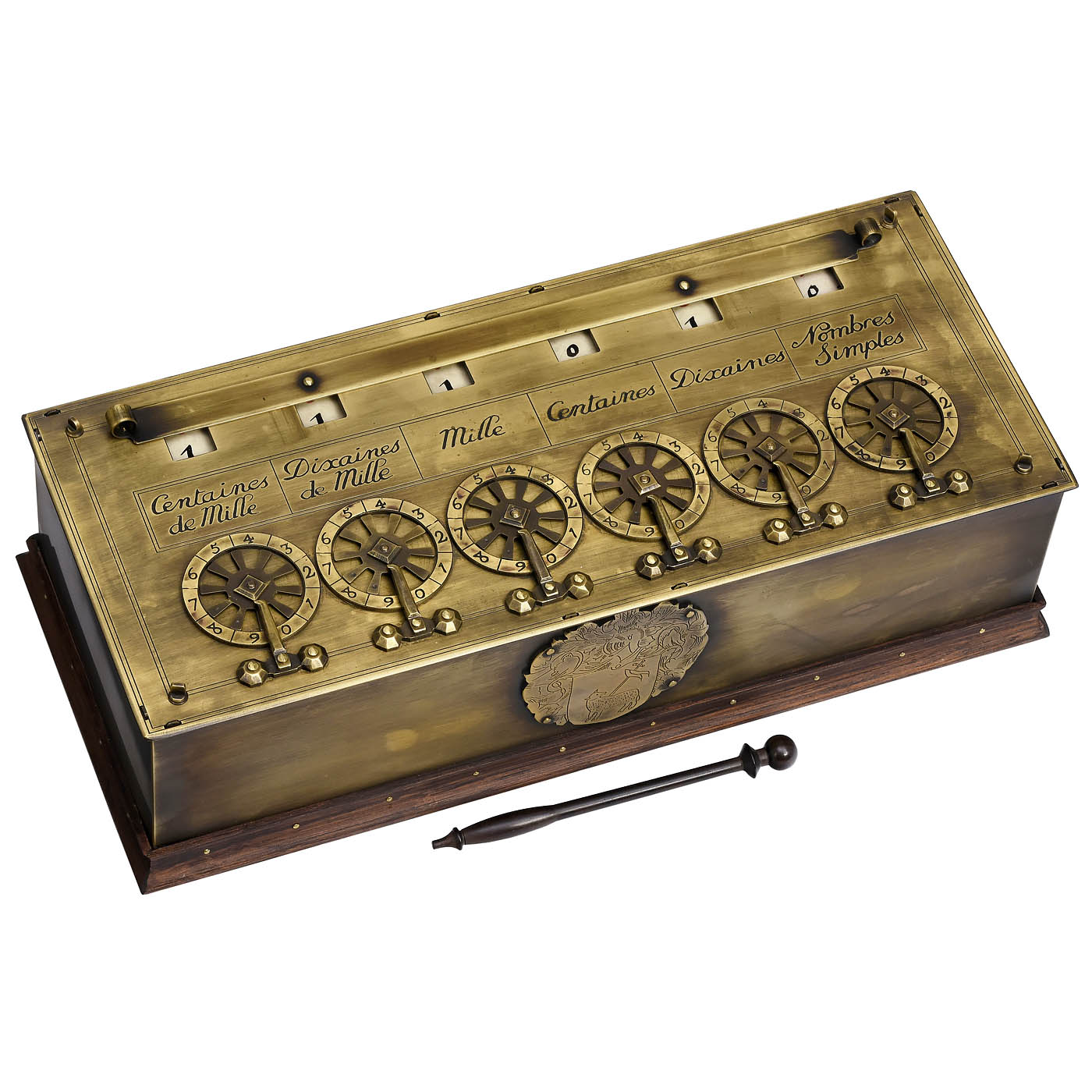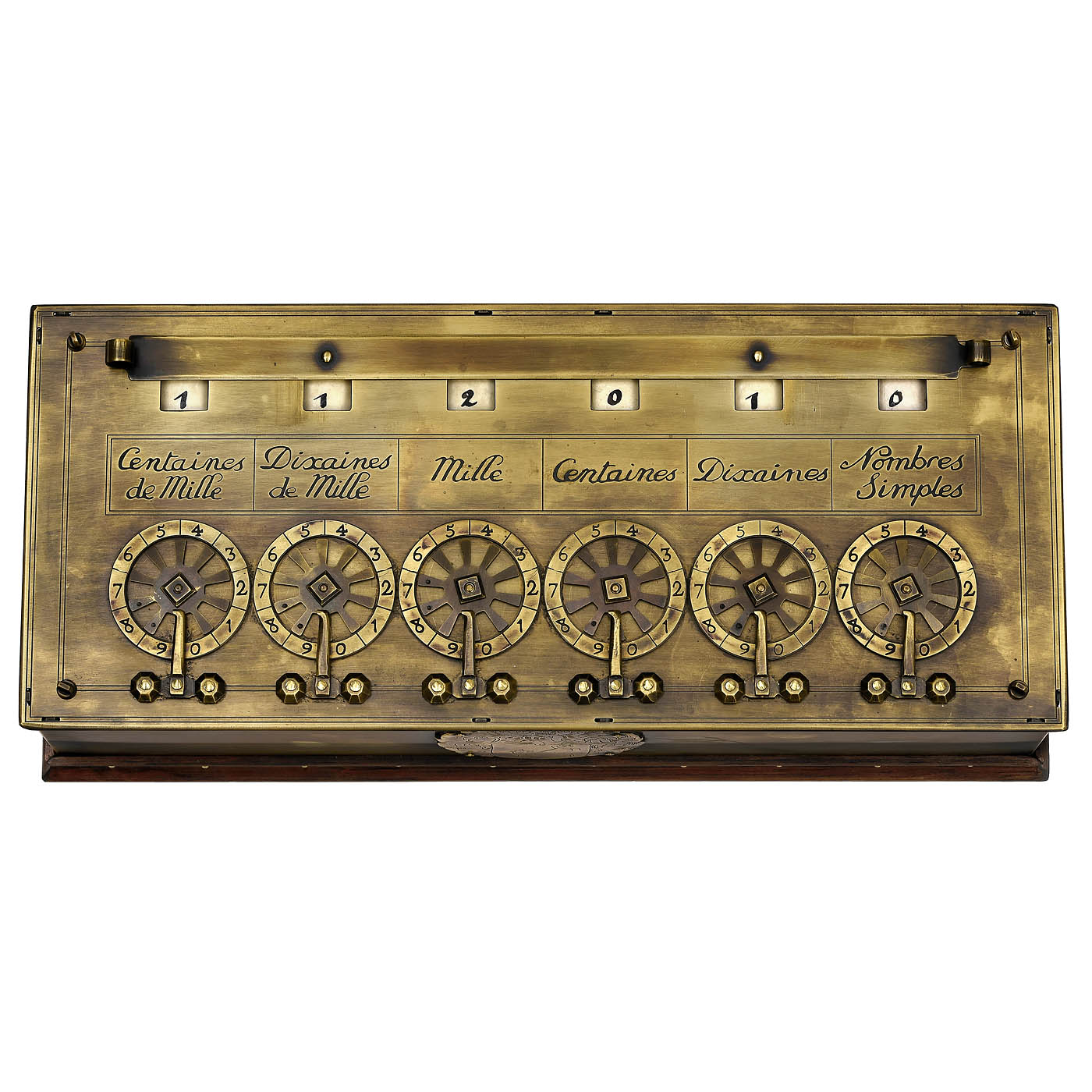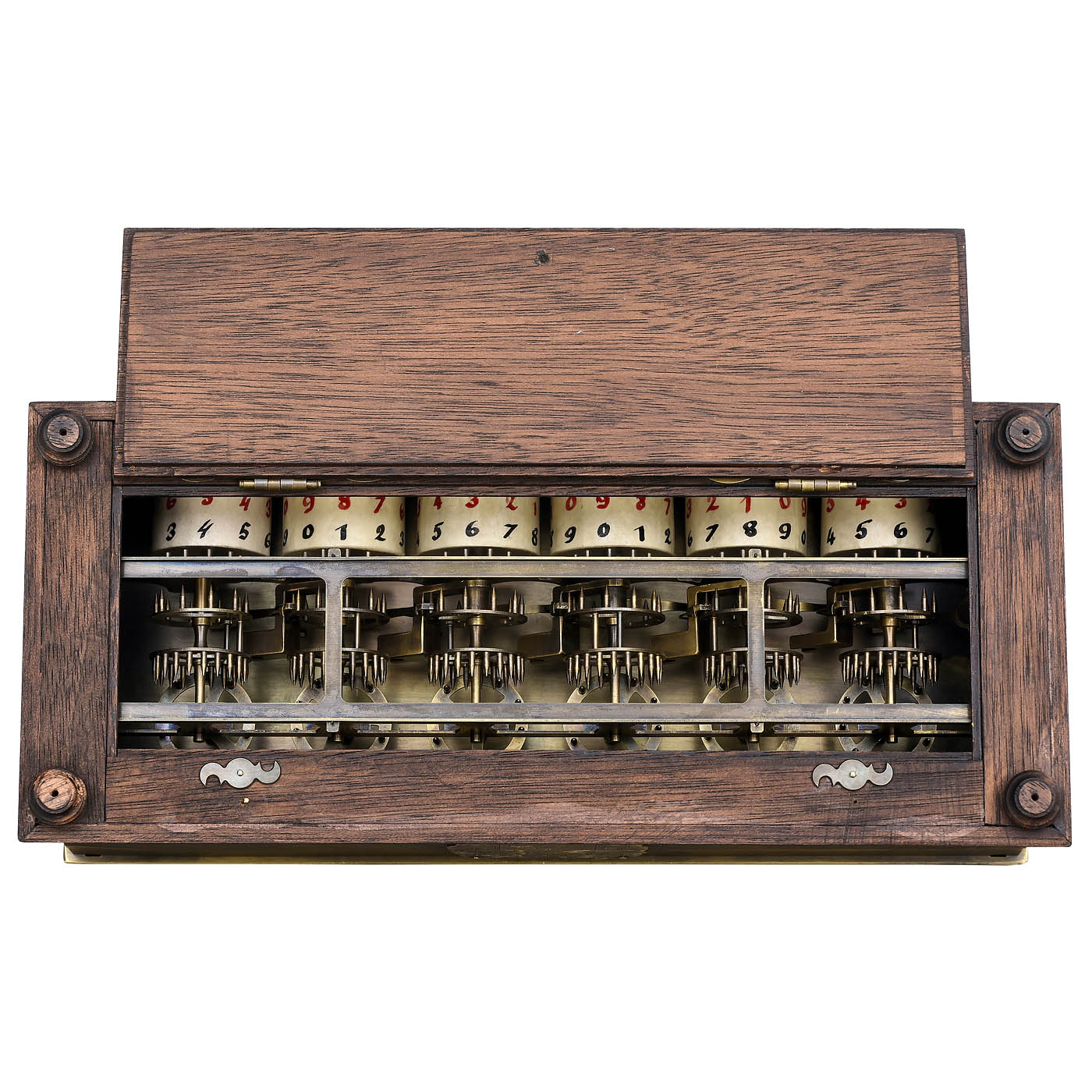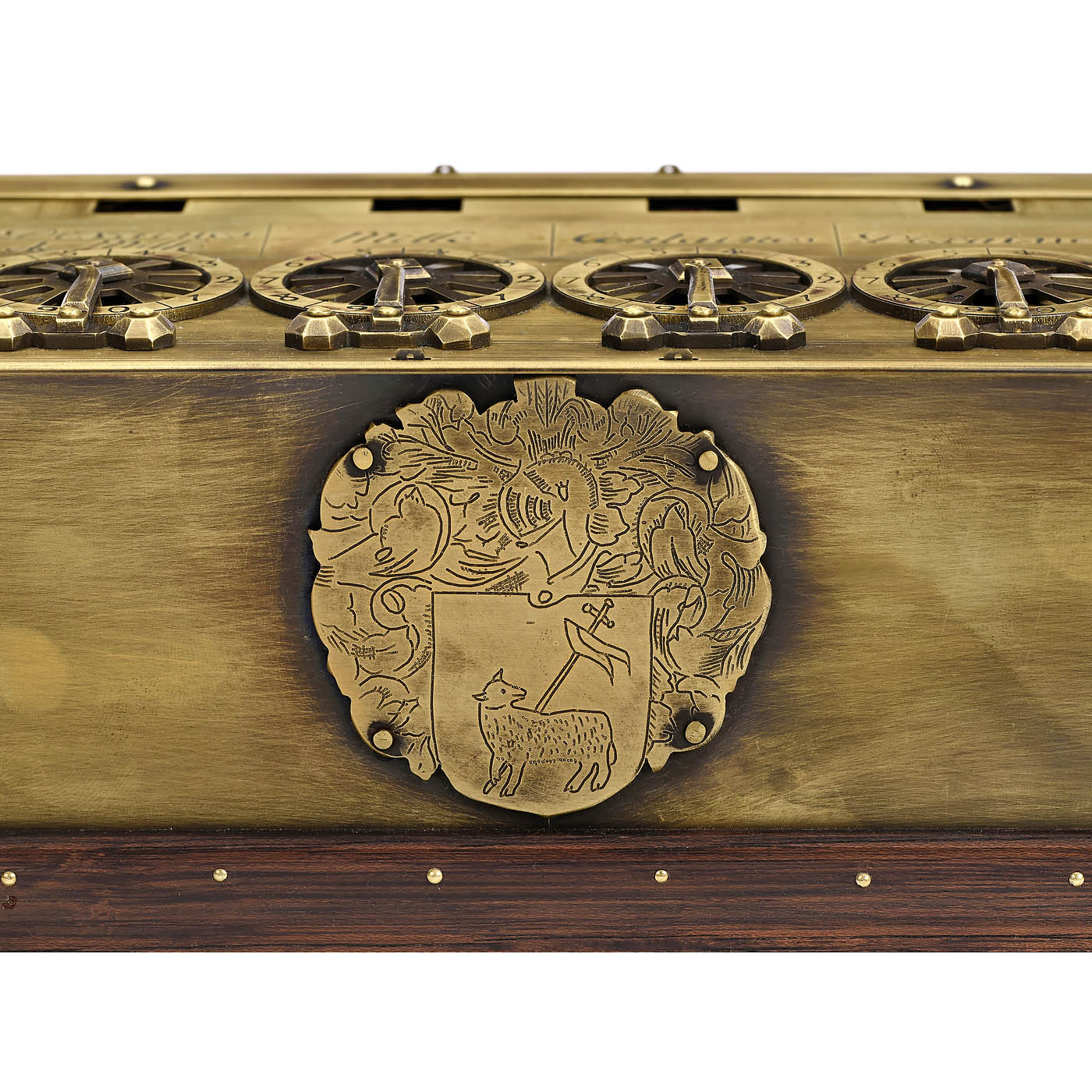



Working Replica of the Six-Digit "Pascaline Calculator"
拍品号:20240914-004
预估价:€ 5000-8000 欧元
起拍价:€ 3000 欧元
成交价:
€ 25188.4 欧元
外观成色:2
布雷克拍品等级是为了方便竞买人判断拍卖品的成色而设置的。布雷克等级用1到6级来标注外观和功能的成色,(从非常好到非常差)。
在目录图册里用括号里的2个数字来表示,前一个数字表示外观成色的级别,后一个数字表示功能成色的级别。如(3/2)表示外观成色是3(满意的),功能成色2(好)。
成色 定义参照下列标准: 1 - 非常好 (未使用过,没有使用痕迹) 2 -
好 (新,极少的使用痕迹) 3 - 满意的 (普通的使用痕迹) 4 -
及格的 (明显的使用痕迹,某个非主要部件是后配的) 5 - 有缺陷的 (极明显的使用痕迹,
某个主要部件是后配的,功能上有缺陷,需要修理) 6 - 非常差 (严重破损, 缺少重要部件)
功能成色:2
布雷克拍品等级是为了方便竞买人判断拍卖品的成色而设置的。布雷克等级用1到6级来标注外观和功能的成色,(从非常好到非常差)。
在目录图册里用括号里的2个数字来表示,前一个数字表示外观成色的级别,后一个数字表示功能成色的级别。如(3/2)表示外观成色是3(满意的),功能成色2(好)。
成色 定义参照下列标准: 1 - 非常好 (未使用过,没有使用痕迹) 2 -
好 (新,极少的使用痕迹) 3 - 满意的 (普通的使用痕迹) 4 -
及格的 (明显的使用痕迹,某个非主要部件是后配的) 5 - 有缺陷的 (极明显的使用痕迹,
某个主要部件是后配的,功能上有缺陷,需要修理) 6 - 非常差 (严重破损, 缺少重要部件)
制造商:
制造年份:
序列号:
拍品描述
With lacquered-brass case, spoked digit-wheels with engraved white-metal scales corresponding (right to left) to: "Nombre Cimple", "dixaines", "Centaines", "mille", "dixaines de mille" and "Cantainnes de mille", sliding rule for changing display from addition to subtraction, brass-framed interior mechanism with six axles each carrying three lantern gears and an inscribed paper-covered drum for the display, on wood plinth with four feet and hinged flap, width 12 in. (31,5) x depth 51/8 in. (13 cm) x height 3 in. (7,8 cm). - Note: Blaise Pascal (1623-1662), mathematician, physicist and philosopher, is credited with the invention of the first mechanical calculator capable of addition and subtraction. His father, Étienne Pascal, was a lawyer and a judge in the tax court who assumed a new position as tax commissioner for Upper Normandy, based in Rouen, in 1639. France had declared war with Spain four years earlier, leading the French government to renege on part of its internal debt and to increase taxation. Étienne - assisted by his son - was under pressure to keep accurate account of the rising tax levies with only the help of counting boards. In 1642 the 19-year old Blaise began designs for a machine that would simplify his father's work. As a reviewer wrote in Le Figaro Littéraire in 1947, "the calculating machine was born of a filial love flying to the rescue of the tax man". - Pascal's first design was for a five-digit calculator; he later refined his principal by creating six and eight-digit machines. Due to the difficulty in cutting toothed gears accurately, Pascal used lantern-type gears formed by pinned wheels that could turn in one direction only. - His design was simultaneously simple and brilliant; the Pascaline could add and subtract two numbers directly and multiply and divide by repetition. The six digit-wheels on the outer case are connected to axles that each carry three lantern gears and a paper-covered drum with inscribed figures. The digit-wheels were rotated by a stylus. For addition, a sliding rule located on the number display was pushed upwards for digits from 0-9. For subtraction, the rule was pushed downwards for digits from 9-0. - The Pascaline was also revolutionary for including digital carry-over. Whenever a ten was carried, a ratchet mounted between the gears, pushed the adjacent gear around a notch, so that the display moved one digit higher. Unfortunately for its operator, a design flaw meant that the ratchets were inclined to jam - perhaps one reason why production of the Pascaline was not financially successful at 100 Livres apiece. It was, however, a mathematical sensation, leading Pascal's friend, the poet Charles Vion Dalibray, to compose a sonnet in its honor: - "... Calculation was the action of a reasonable man, And now your inimitable skill. Has given the power to the slowest of wits". - Pascal accordingly applied for a privilege (the 17th century term for a patent), which was only eventually granted in 1649, after its inventor had presented the issuing officer, Chancellor Seguier, with an 8-digit calculator of his own. - The total production of the Pascaline is not known, however, researchers estimate that no more than 20 examples were produced, of which 9 are known today. It was, nevertheless, an historic achievement, not least for demonstrating "that an apparently intellectual process like arithmetic could be performed by a machine". Its introduction led to the development of mechanical calculators in Europe and, eventually, to the invention of the very first microprocessor, the "Intel 4004", for the "Busicom 141-PF" electronic desk calculator in 1971. Understood in this way, the Pascaline is arguably world's earliest mechanical computer. - Literature: Stan Augarten, "Bit by Bit, An Illustrated History of Computers", 1984, pp. 22-30. - A historically accurate replica from 2011.
成色说明
布雷克拍品等级是为了方便竞买人判断拍卖品的成色而设置的。布雷克等级用1到6级来标注外观和功能的成色,(从非常好到非常差)。
在目录图册里用括号里的2个数字来表示,前一个数字表示外观成色的级别,后一个数字表示功能成色的级别。如(3/2)表示外观成色是3(满意的),功能成色2(好)。
成色 定义参照下列标准: 1 - 非常好 (未使用过,没有使用痕迹) 2 -
好 (新,极少的使用痕迹) 3 - 满意的 (普通的使用痕迹) 4 -
及格的 (明显的使用痕迹,某个非主要部件是后配的) 5 - 有缺陷的 (极明显的使用痕迹,
某个主要部件是后配的,功能上有缺陷,需要修理) 6 - 非常差 (严重破损, 缺少重要部件)
发表评论

